- There are no more items in your cart
- Shipping Calculated at checkout
- Sub-Total (inc. VAT) £0.00
Need Help?
Anti-Static Floor Systems
Specialist anti-static floor systems are vital in environments where electro-static discharge (ESD) threatens sensitive electronics, volatile chemicals, or explosive materials. These systems use electrically conductive coatings to safely dissipate static charges, reducing ignition risks. Ideal for laboratories, electronic assembly plants, and pharmaceutical facilities, they provide a grounding mechanism for personnel and equipment, enhancing safety. Customers can book a site visit from a member of the Rawlins paints’ Technical Team for large floor renovation and refurbishment projects to ensure the correct system is installed. Click for more info.
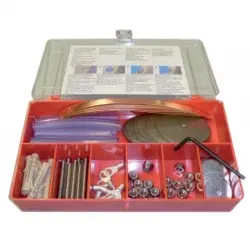
Sikafloor Earthing Kit
A system of anchored brass plates with a stable earth connection. Each box contains 10 connections and at least 2 per room should be used - see coating system data sheet for more details.
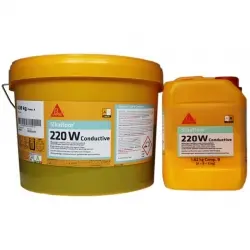
Sikafloor 220 W Conductive
2 part, water dispersed, epoxy resin primer with high electrostatic conductivity. Must be applied as a primer underneath all Sikafloor conductive wearing courses on concrete and cementitious screeds for different types of industrial use.Highly electrostatically conductive Easy application Economical in use Solvent free

Resimac Resichem 593 Epoxy AS
An epoxy based coating system suitable for use in areas where a resistance of less than 10⁸ ohms is required as a measure to control static electricity. After mixing, an easily applied chemical and abrasion resistant finish is produced which is hygienic and easy to clean. Typical applications include factory floors, laboratories, clean rooms,...
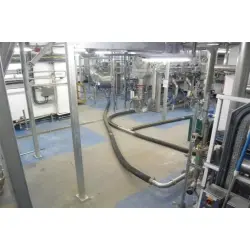
RSL FasTop TG ESD
A heavy duty, water-based polyurethane resin screed in 6 matt anti-slip colours for highly aggressive environments, with anti-static qualities compliant with BS 2050 for industrial applications. High chemical resistance. Thermal shock and abrasion resistance. Resistant to liquids up to 100°C. Decorative. Formerly known as Resustat...
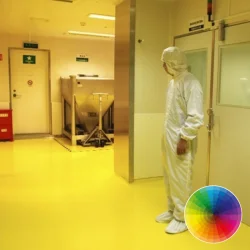
Sikafloor 262 AS N
2-part, self smoothing, coloured epoxy resin, electrostatic conductive system for normal up to medium heavy wear. Particularly suitable for areas with sensitive electronic equipment e.g. CNC machinery, computer rooms, aircraft maintenance sheds, battery-charging rooms and areas subjected to high explosion risks etc.Electrostatic conductive...

Remmers Epoxy Conductive 2K
Two-component, water-based epoxy conductive coating, providing transverse conductivity in dissipative flooring systems. Available in black. Suitable for use as a transverse conducting layer in Remmers dissipative flooring systems and the SL Floor WHG AS system. Electrically dissipative (< 10 kΩ), ensuring effective static discharge...

Remmers Epoxy WHG Color AS 2K
Two-component, dissipative, chemically resistant, crack-bridging epoxy coating in 2,100+ colours. Suitable for industrial floors requiring electrostatic dissipative properties, including warehouses, factories, and areas with heavy machinery. Highly resistant to chemicals, abrasion, and mechanical loads. Certified for slip resistance (R10,...
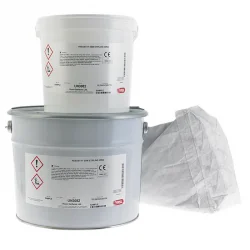
RSL Resuflor SL ESD
Static-dissipative flooring system with epoxy resin components, conductive fillers and pigments to produce a decorative finish. It is also crystalline silica free.Hard wearing Hygienic Chemical, abrasion and impact resistance Decorative Easy to apply Formerly known as Resustat ESM Note: This product is made to order (min. order of 35...
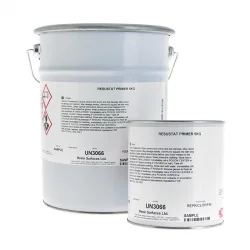
RSL Resuprime ESD
Designed to be applied prior to the use of Resuflor SL ESD, Resustat SL23, FasTop TG ESD or Resuflor Terrazzo. It is a low viscosity epoxy primer with conductive fillers. Conductive with very low electrical resistance Good adhesion Low odour High solids Easy to apply Formerly known as Resustat CP and Resustat Primer
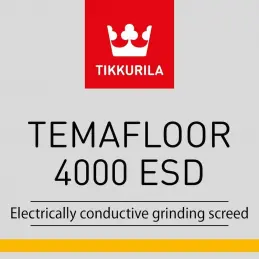
Tikkurila Temafloor 4000 ESD
Forms an electrostatic dissipative flooring system when used together with Temafloor 310 ESD Primer. Static electricity is formed in many industrial processes. The risks and inconveniences can be managed with an electrostatic dissipative flooring system. The flooring system is recommended for floors in the electronic industry, production and...
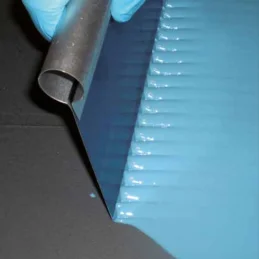
Mapei Mapefloor I 390 EDF
2-pack, self-levelling epoxy formulation in 200+ RAL colours used to form strong, dissipative coatings.Used to form electrically dissipative coatings on concrete substrates and cementitious screeds, including those exposed to medium to heavy traffic. Characterised by a low release of micro-particles and volatile organic compounds (VOC)...
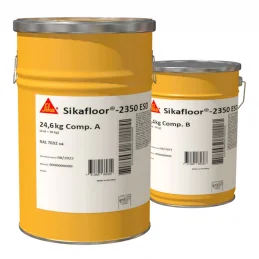
Sikafloor 2350 ESD
2-part self smoothing coloured electrostatic dissipative epoxy resin floor coating for interior concrete or cement screeds.Used as a smooth electrostatically conductive floor covering Reliable long term conductivity Meets ESD requirements - Low VOC emissions Abrasion resistant Low odour during application High mechanical resistance...

Remmers Earthing Kit
For the discharging of electrostatic charges in flooring. Kit for creating 10 connection points. Supplied as a box of 10 kits.Please Note: This product is subject to a lead time of 14-21 Working Days
Need Help?
Need Help?
Anti-static floor systems are advanced, industrial-grade coatings designed to combat the risks associated with electro-static discharge (ESD). In industries where even a minor static charge can cause significant damage, these systems play a critical role. They work by creating an electrically conductive pathway that safely dissipates static electricity into the ground, preventing dangerous accumulations of charge. This technology is crucial in environments that handle sensitive electronic components, flammable chemicals, or explosive materials.
The Critical Need for Anti-Static Floors
Electro-static discharge is more than a minor inconvenience; it's a potential ignition source. When a static charge builds up on standard flooring materials - like vinyl, linoleum, or epoxy - it can suddenly discharge upon contact with a conductive object, creating a spark. In environments such as chemical processing plants or electronic manufacturing facilities, this spark can have catastrophic consequences. Anti-static floor systems mitigate this risk by providing a controlled means for static electricity to be grounded. This grounding process ensures that charges are safely dissipated, preventing the formation of sparks and reducing the likelihood of accidents.
Key Locations for Anti-Static Systems
Anti-static floor systems are essential in a variety of environments, each with specific safety and operational requirements:
Laboratories
Laboratories often contain sensitive equipment and instruments that can be adversely affected by static charges. For example, mass spectrometers, electron microscopes, and other diagnostic tools require a controlled environment free from static interference. Anti-static floors protect these instruments, ensuring the reliability of test results and prolonging the lifespan of costly equipment.
Computer Suites and Data Centres
Computer suites and data centres house vast amounts of electronic equipment, including servers and networking devices, which are particularly vulnerable to ESD. A single electro-static discharge can cause significant damage to these components, leading to data loss, system failures, and costly repairs. Anti-static flooring helps prevent such occurrences, ensuring the integrity and continuity of operations in these critical environments.
Electronic Assembly Plants
In facilities where electronic components are assembled, such as circuit boards and microprocessors, even the smallest static discharge can destroy or degrade these components. Anti-static floors provide an essential safeguard, reducing the risk of ESD during assembly and ensuring product quality.
Automotive and Aeronautical Departments
These sectors involve complex manufacturing processes that rely on sensitive electronics and machinery. Static charges can disrupt these processes, leading to production errors and equipment damage. Anti-static floors ensure a controlled environment, protecting the integrity of electronic systems and enhancing safety during the manufacturing of vehicles and aircraft components.
Pharmaceutical and Medical Facilities
In pharmaceutical manufacturing and medical facilities, static can attract dust, microbes, and other contaminants, compromising the sterility of the environment. This can lead to product contamination or affect the outcome of medical procedures. Anti-static flooring ensures a clean, controlled environment, vital for patient safety and the integrity of pharmaceutical products.
Manufacturing Plants
In general manufacturing, where automated machinery and electronic systems are prevalent, static electricity can cause malfunctions, leading to downtime and potential safety hazards. Anti-static floors protect machinery from static damage, ensuring smooth operations and reducing maintenance costs.
Oil and Chemical Processing Facilities
These environments handle volatile substances where any spark can ignite a hazardous situation. Anti-static flooring is a mandatory safety measure, reducing the risk of ignition and ensuring compliance with safety regulations in facilities that process and store chemicals and petroleum products.
Establishing Electrostatic Protected Areas (EPA)
In environments where the risk of electro-static discharge is particularly high, such as in television production plants or facilities handling explosive materials, establishing an Electrostatic Protected Area (EPA) is essential. These areas, coated with epoxy-based anti-static systems, ensure that any electro-static charge is dissipated into the ground instantaneously. This rapid dissipation prevents the accumulation of static on surfaces, equipment, or personnel, thereby reducing the risk of system overloads or explosive incidents.
Types of Anti-Static Systems
Selecting the appropriate anti-static system depends on the specific requirements of the environment. The primary types include:
AS (Anti-Static) Systems
These systems are designed to prevent the build-up of static electricity on surfaces. They are suitable for environments where static control is necessary but not critical. AS systems offer a basic level of protection by reducing the tendency of floors to generate static charges. They are commonly used in environments like offices and retail spaces where electronic equipment is used, but the risk of static damage is relatively low.
ECF (Electrically Conductive Flooring) Systems
ECF systems provide a higher level of conductivity, making them suitable for environments where rapid dissipation of static electricity is crucial. These systems are engineered to create a conductive pathway that directs static charges safely to the ground. ECF systems are ideal for settings like electronic assembly plants and data centres, where the prevention of ESD is vital for protecting sensitive equipment.
ESD (Electro-Static Discharge) Systems
ESD systems are specifically designed to protect sensitive electronic components and equipment from static discharge. They ensure safe and controlled dissipation of electrical charges, preventing ESD events that can damage or degrade electronic devices. ESD systems are essential in environments such as clean rooms, electronic manufacturing facilities, and healthcare settings, where even a minor static discharge can cause significant issues.
Epoxy-Based Systems
Epoxy-based anti-static systems are commonly used in high-risk environments due to their durability and effectiveness. These systems offer long-lasting protection against ESD and can be customised to meet the specific needs of different industries. They are ideal for areas like manufacturing plants, laboratories, and facilities handling volatile substances.
Book a Site Visit for Large Floor Renovation and Refurbishment Projects
Painting floors with high-quality commercial or industrial coatings is much more cost effective and less disruptive to a project than using cheaper substitutes. Larger projects require some form of ‘guarantee’ for the client and/or building owner to provide peace of mind that the coating system applied to internal or external flooring will last for an agreed period of time - if correctly maintained.
Using our products, it is possible to decorate and protect concrete, tarmac, asphalt, wood or metal floors, both improving its life expectancy for greater periods of times, and delivering waterproofing and protective properties that can lower the risk of major repair and costly maintenance work. Achieve long-lasting results, with the wide range of floor paints and coatings available at Rawlins Paints today.
We offer systems that are available in virtually any colour and finish - including colour matching existing decorative or company colour schemes - in our light to medium (pedestrianised) right up to heavy use (light to medium vehicular activity) coatings for a wide range of interior or exterior substrates and surface materials.
A trained member of our Technical Support Team will visit your site and carry out a full inspection, write a tailored specification to meet your requirements and offer an approved contractor for the application. We will never offer a contractor that we have not trained and approved, all our contractors have successfully completed specific product training on the systems they apply and are monitored regularly to ensure the highest standard of quality is achieved.
By using one of our nationwide approved contractors for our products you enable yourself to take advantage of our guarantees, life expectancies and warranties. This means if we say our system is going to last a certain amount of time, or perform in a certain way and it doesn’t, you’re covered.
If you’re a contractor and would like to become an approved installer of our systems please contact us on 0113 245 5450
